By mental performance coach Brian Cain
As someone who cares about fitness, you know the importance of what happens inside the gym; but a huge part of recovery for optimal performance takes place outside of the gym, inside our heads.
Developing strategies to “turn off” the stress response and shift into recovery mode gives you a massive advantage in today’s intensity-driven, grind-or-die culture.
Plain and simple, managing stress is key for personal fitness success, whether that means losing weight or setting a PR.
Mental stress takes up a lot of your limited energy reserves and sabotages recovery. Ultimately, it limits the level of results you’ll see from the work you put in at the gym.
If you don’t address the mental side of recovery, it won’t matter how intelligent your programming is or how hard you’re willing to work; your health, fitness, and performance will suffer.
It’s THAT important.
That’s why I want to share a simple, 4-step process you can use to combat stress.
This is the same process I use to help world-champion UFC fighters stay calm in the cage, winning pitchers release stress and stay focused on the mound in front of millions of people—and you can use it to manage your day-to-day stress.
The 4-step process to turn off stress, ramp up recovery, and get better results
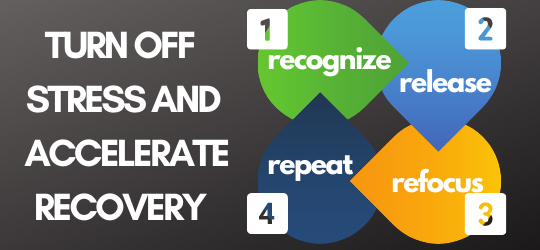
Step #1: Recognize
That which you’re aware of, you can change. That which you’re NOT aware of, you can’t do anything about.
The first step toward combating stress in your life is to recognize when and where it’s happening so you can begin to DO something to offset it.
To provide a concrete, visual of how you can heighten your awareness and become more attuned to stressful situations, I use a process called “recognizing your signal lights.”
This idea of “signal lights of stress” is just like driving a car.
If you’re driving your car and you come to a green light, you GO. There isn’t any thought process, you just go. But if you’re driving your car and you come to a yellow or red light, you slow down and STOP.
You can use this same concept to evaluate your stress levels, and if necessary, stop it in its tracks, turn it off, and get your body back into balance.
Simply becoming more aware of when your stress levels are rising to a yellow or red level is a great place to start, but I want to give you a method I use to help identify your signal lights, called “BFS.”
BFS is an acronym that stands for body language, focus, and self-talk.
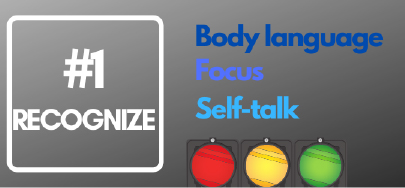
By evaluating these three components, you can get a clear idea of whether your stress levels are a green, yellow, or red light. Let me roll through an example for you…
Body Language: In a green light situation (where stress is low), my body language is big, strong, my shoulders are back, head is up; I feel good, in control.
In a yellow or red light situation—where stress is building or at a point where it’s negatively affecting health and performance—my body language is small, my shoulders are slumped, back is tight, I just feel stiff.
Focus: In a green light situation, I’m in a state of present awareness where I’m dialed in on what I’m doing right now and why it’s important. In a yellow or red light situation, my focus is on the past or on the future; it’s on outcomes, not the process.
Self-Talk: In a green light situation, self-talk is often third person and confident: “You’ve got this.” In a yellow or red light situation, self-talk is usually third person and it’s negative: “I can’t believe you did that, you always make these kinds of mistakes.”
Your body language, focus, and self-talk are like a temp gauge for your stress levels. If more than one of these is trending toward a yellow or red light situation, you have to be able to recognize that and put a plan into place to turn things around—we’ll get to that in a minute.
For now, I want you to practice becoming more aware of your BFS so you can identify where your stress levels are at. This can take time, but it’s well worth it. With time, being able to instantly evaluate your “BFS” will become like second nature to you.
Use the “BFS” process to evaluate where your signal lights of stress are at:
- If you’re hitting green lights: Keep cruising.
- If you start hitting yellow and red lights: STOP — and apply the “release and refocus” process we’re going to cover next…
Step #2: Release
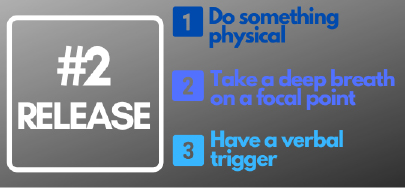
When you recognize a yellow or red light with BFS, you need to immediately go into a release routine to turn off the stress response and get back into recovery mode.
Your 3-step release routine is to:
- Do something physical.
- Take a deep breath on a focal point.
- Have a verbal trigger.
Step #1: Do something physical. The idea here is to take a physical action that initiates your release routine. This might be clapping your hands together forcefully, taking a piece of paper and throwing into the garbage can.
Step #2: Take a deep breath on a focal point. A focal point is a spot you look at while taking a deep breath that reminds you to come back to the present moment.
You could use a sticky note on your desk or computer with the word “focus” on it. Maybe you focus on the watch on your wrist to remind you to focus on the present moment. The options are limitless, but the idea is the same: find something you can use to come back to the present moment and “go green.”
Step #3: Have a verbal trigger. The verbal trigger is the final signal that releases us from the stressful situation, knocking us back into recovery mode and bringing us back to the present moment.
Your verbal trigger could be as simple as saying the word “release,” to indicate letting go of the stress you’re experiencing.
Or, maybe you’ll say “recover” to tell your body and mind, “Hey, we’re letting this stress go and getting back into a state of recovery.”
The most important thing is to choose a verbal trigger you can remember that will effectively get you back to the present moment.
Putting this all together:
Any time your BFS indicates that your stress is at yellow or red light levels, immediately go into your release routine: do something physical, take a deep breath on a focal point, and say your verbal trigger.
Step 3: Refocus
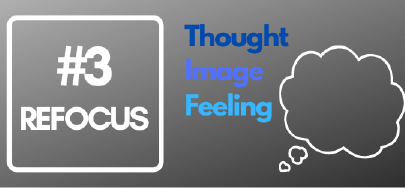
When you recognize a yellow or red light, you immediately go into your release routine. The final step in the process is to refocus. Let’s now talk about two steps in training your refocus:
- Take a deep breath on a focal point.
- Have a final thought, image, or feeling, or what I often call a TIF.
First, take a deep breath. When you finish the release routine we outlined in step 2, you simply take a deep breath to focus on what you’re going to do next.
You’re essentially resetting—or refocusing—your body and your mind to be in a state of focus and relaxation.
Finally, you complete the process with a final thought, image, or feeling that helps you refocus on being in a peaceful, green light situation.
This could be thinking about how confident you’ll feel if you make the difficult, healthy nutrition choice; or feeling what it will be like to sink the game-winning free throw.
The idea is to choose a final TIF that will help release the stress of that situation and refocus what’s going to get you back to a place of peace and recovery.
Step #4: Repeat
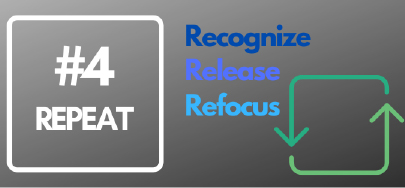
This one’s simple, but not necessarily easy — repeat the process any time you’re feeling stressed and overwhelmed, or when your BFS indicates your stress levels are in a yellow or red light situation.
With practice, you’ll discover applying this process is something you can do in just a few seconds—and it’s something you can literally use over and over again throughout the day.
Over time, the compound effect will kick in, often leading to life-changing results.
Action Step
By applying the stress-release process you’ve learned today, not only will you be able to improve the ability to turn off stress and get back into recovery mode, you’ll also notice that you’re able to stay calm under pressure and make better choices.
Take a moment to identify your BFS signal lights, write out a 3-step release routine, and choose a refocusing TIF.
Play out how you’ll go through this process the next time you’re mentally stressed.
